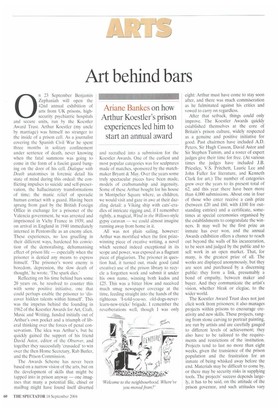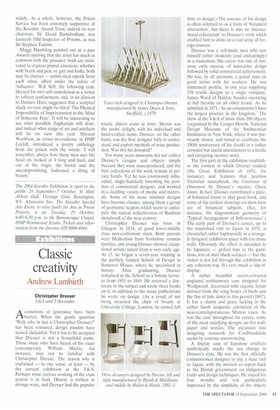Art behind bars
Ariane Bankes on how Arthur Koestler's prison experiences led him to start an annual award
0 n 23 September Benjamin Zephaniah will open the 42nd annual exhibition of arts from UK prisons, highsecurity psychiatric hospitals and secure units, run by the Koestler Award Trust. Arthur Koestler (my uncle by marriage) was himself no stranger to the inside of a prison cell. As a journalist covering the Spanish Civil War he spent three months in solitary confinement under sentence of death, never knowing when the fatal summons was going to come in the form of a fascist guard banging on the door of his cell, Dialogue with Death anatomises in forensic detail his state of mind during this ordeal: the conflicting impulses to suicide and self-preservation, the hallucinatory transformations of time; the manic relief of sporadic human contact with a guard. Having been sprung from gaol by the British Foreign Office in exchange for a prisoner of the Valencia government, he was arrested and imprisoned in Vichy France in 1939, and on arrival in England in 1940 immediately interned in Pentonville as an enemy alien. These experiences, no less gruelling in their different ways, hardened his conviction of the demoralising, dehumanising effect of prison life — especially when the prisoner is denied any means to express himself. The prisoner's worst enemy is boredom, depression, the slow death of thought,' he wrote. 'The spark dies.'
Reflecting on his time behind bars some 20 years on, he resolved to counter this with some positive initiative, one that could perhaps enable the prisoner to 'discover hidden talents within himself. This was the impetus behind the founding in 1962 of the Koestler Awards for Art, Craft, Music and Writing, funded initially out of Arthur's own pocket and a triumph of liberal thinking over the forces of penal conservatism. The idea was Arthur's, but he quickly gained the support of his friend David Astor, editor of the Observer, and together they successfully 'crusaded' to win over the then Home Secretary, Rab Butler, and the Prison Commission.
The Awards Scheme has never been based on a narrow vision of the arts, but on the development of skills that might be tapped into in prison anyway — one imagines that many a potential file, chisel or mailbag might have found itself diverted and recrafted into a submission for the Koestler Awards. One of the earliest and most popular categories was for sculptures made of matches, sponsored by the matchmaker Bryant & May. Over the years some truly spectacular pieces have been made, models of craftsmanship and ingenuity. Some of these Arthur bought for his house in Montpelier Square where, as children, we would visit and gaze in awe at their dazzling detail: a Viking ship with cats'-cradies of intricate rigging and, if I remember rightly, a magical, Wind in the Willows-style gypsy caravan — we could almost imagine running away from home in it.
All was not plain sailing, however: Arthur was mortified when the first prizewinning piece of creative writing, a novel which seemed indeed exceptional in its scope and power, was exposed as a flagrant piece of plagiarism. The prisoner in question had, it turned out, made good (and creative) use of the prison library to recycle a forgotten work and submit it under his own name, winning both kudos and £25. This was a bitter blow and received much smug newspaper coverage at the time, feeding straight into the hands of the righteous 'I-told-you-so, old-dogs-neverlearn-new-tricks' brigade. I remember the reverberations well, though I was only eight: Arthur must have come to stay soon after, and there was much commiseration as he fulminated against his critics and vowed to carry on regardless.
After that setback, things could only improve. The Koestler Awards quickly established themselves at the core of Britain's prison culture, widely respected as a genuine and positive initiative for good. Past chairmen have included A.D. Peters, Sir Hugh Casson, David Astor and Sir Stephen Tumim, and a roster of expert judges give their time for free. (At various times the judges have included J.B. Priestley, V.S. Pritchett, Laurie Lee and John Fuller for literature, and Kenneth Clark for art.) The number of categories grew over the years to its present total of 62, and this year there have been more than 4,000 submissions. About one in four of those who enter receive a cash prize (between £20 and £60, with £100 for outstanding entries) and a certificate, sometimes at special ceremonies organised by the establishments to congratulate the winners. It may well be the first prize an inmate has ever won, and the annual Awards exhibition offers a chance to reach out beyond the walls of his incarceration, to be seen and judged by the public and to sell work in an open market. That, for many, is the greatest prize of all. The works are displayed anonymously, but they are seen and purchased by a discerning public: they form a link, presumably a bond of empathy, between maker and buyer. And they communicate the artist's vision, whether bleak or elegiac, to the wider world.
The Koestler Award Trust does not just elicit work from prisoners; it also manages projects within prisons to encourage creativity and new skills. These projects, ranging from stone carving to portrait painting, are run by artists and are carefully gauged to different levels of achievement; they also have to be tailored to the requirements and restrictions of the institution. Projects tend to last no more than eight weeks, given the transience of the prison population and the frustration for an inmate of being whisked away before the end. Materials may be difficult to come by, or there may be security risks in supplying tools. The projects' success depends largely, it has to be said, on the attitude of the prison governor, and such attitudes vary widely. As a whole, however, the Prison Service has been extremely supportive of the Koestler Award Trust; indeed its new chairman, Sir David Ramsbotham, was formerly HM Inspector of Prisons, as was Sir Stephen Tumim.
Maggi Hambling pointed out at a past Awards opening that the artist has much in common with the prisoner: both are motivated to express primal emotions, whether with brush and pen, or gun and knife; both may be thieves — artists steal openly from each other, albeit under the rubric of 'influence'. Will Self, the following year, likened his own self-immolation as a writer to solitary confinement, and, in an allusion to Damien Hirst, suggested that a sculpted shark on view might be titled 'The Physical Impossibility of Imprisonment in the Mind of Someone Free'. It will be interesting to see what parallels Zephaniah will draw, and indeed what range of art and artefacts will be on view this year. Shivaun Woolfson, as writer-in-residence at HMP Leyhill, introduced a poetry anthology from the prison with the words: 'I will remember always how these men met life head on, looked at it long and hard, and out of the tragic, the brutal and the uncompromising, fashioned a thing of beauty.'
The 2004 Koestler Exhibition is open to the public 24 September-7 October, St Mary Abbots Hall, Vicarage Gate, Kensington, W8. Admission free. The Koestler Special Arts Event, to raise funds for Arts in Prison Projects, is on Tuesday, 19 October, 6.00-8.30 p.m. in the Romanesque Chapel, HMP Wormwood Scrubs. Tickets and information from the director, 020 8868 4044.



















































































 Previous page
Previous page